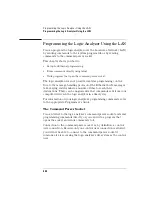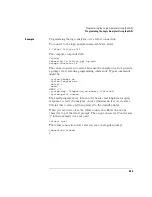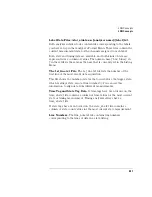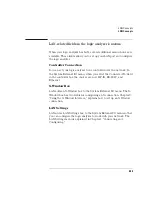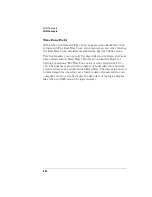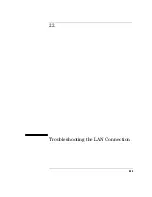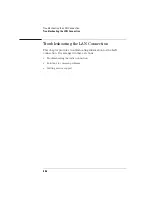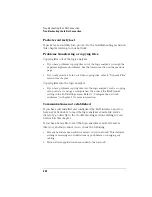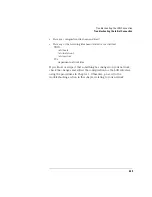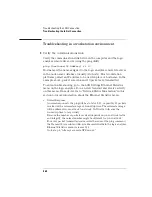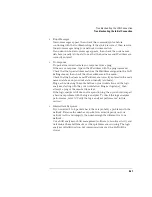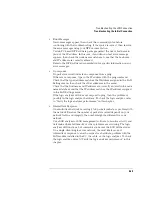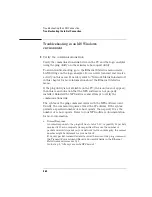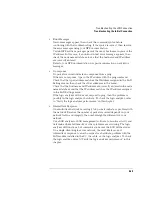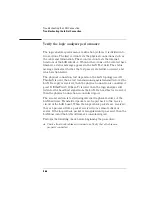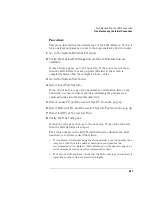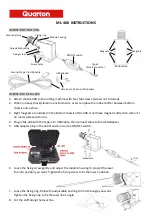
552
LAN Concepts
LAN Concepts
Dynamic files
The logic analyzer’s file system uses dynamic files for configuration
information and data. This means that applications such as File
Manager or a spreadsheet cannot determine the size of the files until
they are retrieved.
When you view the file statistics for these files, you will see file sizes of
0 bytes or 1 byte. The 0-byte size indicates that the file is empty. The 1-
byte size indicates that there is information in the file. If you transfer
the file of interest to your PC or workstation, you will be able to see the
actual file size.
Known Incompatibilities
Some operating systems and applications may exhibit unexpected
behavior when working with the dynamic files from the logic analyzer.
The "%complete" display may appear incorrect during file transfers.
This does not affect the transfer or the contents of the file. Once you
have saved the file in your local environment, the correct "% complete"
will be displayed during future retrievals.
Your applications might only retrieve one or two characters from a file
that you believe has many more characters in it. To work around this
problem, copy the file that you want to work with from the logic
analyzer to your local computer. Use the local copy as your working
copy.
SUN Operating Systems
The file copy commands in the SUN workstation and Solaris operating
systems will not work with the dynamic files like those used in the logic
analyzer. You can use the dd command instead of using the cp or cat
commands.
Summary of Contents for 1670E Series
Page 6: ...6 In This Book...
Page 26: ...26 Contents...
Page 27: ...27 Section 1 Logic Analyzer...
Page 28: ...28...
Page 29: ...29 1 Logic Analyzer Overview...
Page 39: ...39 2 Connecting Peripherals...
Page 49: ...49 3 Using the Logic Analyzer...
Page 72: ...72 Using the Logic Analyzer The Inverse Assembler...
Page 73: ...73 4 Using the Trigger Menu...
Page 101: ...101 5 Using the Oscilloscope...
Page 151: ...151 6 Using the Pattern Generator...
Page 199: ...199 7 Triggering Examples...
Page 237: ...237 8 File Management...
Page 249: ...249 9 Logic Analyzer Reference...
Page 360: ...360 Logic Analyzer Reference The Compare Menu...
Page 361: ...361 10 System Performance Analysis SPA Software...
Page 397: ...397 11 Logic Analyzer Concepts...
Page 430: ...430 Logic Analyzer Concepts The Analyzer Hardware Oscilloscope board theory Oscilloscope board...
Page 439: ...439 12 Troubleshooting the Logic Analyzer...
Page 455: ...455 13 Specifications...
Page 471: ...471 14 Operator s Service...
Page 479: ...479 Operator s Service Troubleshooting Troubleshooting Flowchart 2...
Page 491: ...491 Section 2 LAN...
Page 492: ...492...
Page 493: ...493 15 Introducing the LAN Interface...
Page 497: ...497 16 Connecting and Configuring the LAN...
Page 506: ...506 Connecting and Configuring the LAN Connecting and Configuring the LAN...
Page 507: ...507 17 Accessing the Logic Analyzer File System Using the LAN...
Page 515: ...515 18 Using the LAN s X Window Interface...
Page 527: ...527 19 Retrieving and Restoring Data Using the LAN...
Page 539: ...539 20 Programming the Logic Analyzer Using the LAN...
Page 546: ...546 Programming the Logic Analyzer Using the LAN Programming the Logic Analyzer Using the LAN...
Page 547: ...547 21 LAN Concepts...
Page 555: ...555 22 Troubleshooting the LAN Connection...
Page 580: ...580 Troubleshooting the LAN Connection Getting Service Support...
Page 581: ...581 Section 3 Symbol Utility...
Page 582: ...582...
Page 583: ...583 23 Symbol Utility Introduction...
Page 588: ...588 Symbol Utility Introduction Symbol Utility Introduction...
Page 589: ...589 24 Getting Started with the Symbol Utility...
Page 597: ...597 25 Using the Symbol Utility...
Page 609: ...609 26 Symbol Utility Features and Functions...



